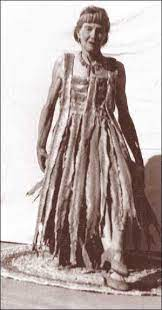I've been in Colorado over 50 years. I lived in Keenesburg near Hudson, and I've visited Greeley several times, yet only recently did I learn of Rattlesnake Kate.
There is a museum and a huge amount of information "out there" on Kate, so I'll hit the amazing highlights, which I'm sure will spur you on to doing more reading and research.
Kate (1893-1969) was an independent lady, and progressive for the time. Married and divorced several time, she loved shooting guns and working hard, and had been a trained nurse and taxidermist. Rumor has it that she was also a bootlegger.
On October 28, 1925, Katherine McHale Slaughterback was out with her 3-year old adopted son Ernie. They were on horseback and headed toward a lake near her farm in Hudson, Colorado
(restored residence)
She'd heard what sounded like hunters, and was riding to a pond with Ernie, to gather any wounded ducks left by hunters so they could have them for dinner.
Climbing down from her horse to unlock the gate, she saw the first snake. Hundreds of migrating rattlesnakes followed. Kate fired her .22 Remington rifle until no bullets remained. Having disturbed and agitated the snakes, they soon surrounded Ernie, Kate and her horse.
Out of ammunition and terribly worried about Ernie and her horse, Kate grabbed a nearby sign—ironically it’s believed to have been a “No Hunting” sign. Equipped only with this wooded weapon, she began killing the rattlesnakes, one-by-one, until all were dead.
According to Kate, “I fought them with a club not more than 3 feet long, whirling constantly for over two hours before I could kill my way out of them and get back to my faithful horse and Ernie, who were staring at me during my terrible battle not more than 60 feet away."
A neighbor saw her soon after she got home. She had blisters on her hands and her face was swollen from the heat. The neighbor went back to the pond with Kate. The battle had been a tough one, and they picked up 140 snakes collected in three large washtubs then hung on a line to dry.
The neighbor told other people about Kate's adventure. Soon reporters came to hear Kate's experience which made her famous. Newspapers carried the story all over the world. The story was retold for many years and she was known as the world champion rattlesnake killer.
Handy at taxidermy, Kate knew how to cure animal skins so they could be kept. She used over 50 of the skins to make a flapper style dress on display at the Greeley City Museum. She also used snake skins for a pair of shoes and a neck band.
But it wasn't all killing snakes and no fun out there on the prairie. There was a long distance romance in her life, the other party being Buckskin Bill Randolph, the poet of the plains.
They might not have shared the touching romance of his poetry, but they did share a friendship through correspondence that spanned almost 40 years.
There came a 23 year silence between them when WWII came about. Buckskin Bill married and was a guard at the Rock Island Arsenal. Kate became a Red Cross nurse stationed in Pusan, Korea and Nagasaki, Japan. Later, Bill attempted to write a biography of Kate, to seal a place for her in the history of the Wild West.
Kate would wear the dress to many functions. She later kept it inside a trunk where curious family members would sneak peeks at it. She would not allow it to be photographed because she thought it would lessen the dress' value.
In 2022, a play about her premiered at the Wolf Theater in Denver, and quickly became a global sensation.
Three weeks before she died, at age seventy-five, she left her dress to the Greeley Museum along with other artifacts related to her rattlesnake legacy. By request, she's buried in Platteville, Colorado.











Interesting post, Gini. I've heard of Kate but never knew her claim to fame. I'm pretty sure I assumed she was a female outlaw. Thanks for sharing, and btw, I could never wear that dress. I couldn't even wear snakeskin boots. Not a fan of the little buggers.
ReplyDeleteYikes, what a story! Thanks, Gini
ReplyDelete